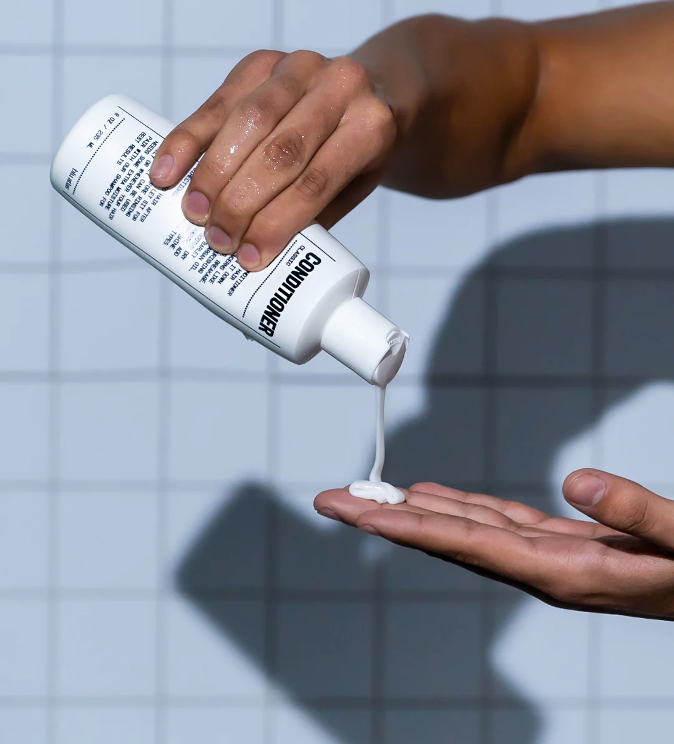Conditioner is a superhero for hair, helping make it shiny, soft, and manageable. But how often should you use it? This question can be answered by looking at different factors surrounding your hair, like what type of conditioner you’re using and your hair type.
Your hair is unique. This means you’ll need to find the balance of moisture: not too much conditioning, which can leave hair feeling greasy and heavy, and not too little, which can leave hair dying of thirst.
In this article, we discuss how often you should use conditioner and which type might work best for your hair.
What is Conditioner?
If you’re one of the many people wondering what conditioner does, know you’re not alone. Conditioners are hydrating formulas made with moisturizing agents (like oils, silicones, and emollients) to add moisture to the hair and treat issues like dryness, frizz, and breakage.
How Often Should You Use Conditioner?
There are four popular types of conditioner. Each should be used at different frequencies and can help with various issues.
When choosing a conditioner, consider your hair type (curly, kinky, straight, and wavy) and any concerns like oily hair, dryness, or a flaky scalp.
Rinse-Out Conditioner
The most common type is rinse-out conditioner, which is what you’ll often think of when you hear the word “conditioner.” It’s the hair care product you apply after shampooing and rinse out after a few minutes.
How often should you use a rinse-out conditioner? The American Academy of Dermatology (AAD) recommends using conditioner after every shampoo and cleansing session. If you’re following a regular 7-day hair care routine, you’ll likely shampoo and condition hair two to three times per week.
Those with fine, thin, or oily hair should wash and condition it less frequently because it can make it look greasy and weigh it down. On the other hand, those with dry, thick, coarse, kinky, coily, or color-treated hair would likely benefit from conditioning it more frequently. Depending on your hair, this may be as often as daily or every other day.
Leave-in Conditioner
Leave-in conditioner is an extra hydrating hair tool that you can apply after shampooing and conditioning hair. It’s a follow-up treatment you can use during your post-shower grooming rituals.
The AAD recommends leave-in conditioners for those with long, curly, dry, thin, frizzy, and color-treated hair—some board-certified dermatologists like Zoe. D Draelos, MD, FAAD, shares that leave-in conditioners can benefit hair and are an excellent tool for those with chemically treated hair.
How often should you be using it? Those with thin, fine, or oily hair should use leave-in conditioner sparingly. Anyone with dry, curly, thick, coarse, coily, kinky, dry, or chemically-treated hair can use leave-in conditioner daily.
Deep Conditioner
Deep conditioners are intense moisturizing treatments for hair. They are the most time-consuming hydrating treatment, and after applying them, you allow them to sit on your hair for 30 to 45 minutes (or as otherwise instructed).
They are ideal conditioning treatments for thick, coily, curly, dry, or damaged hair. They are designed to restore hair while offering uber moisture. Most deep conditioners are intended for use once a month or every two months.
Cleansing Conditioner
While “cleansing conditioner” might sound like an oxymoron, it actually refers to the popular 2-in-1 or 3-in-1 cleansing and conditioning products that can cleanse and condition your hair at the same time.
Cleansing conditioners eliminate the need for extra products and streamline your morning or evening routine. Due to their unique formula, they’re usually lighter than other conditioners and don’t weigh down the hair, making them a good choice for folks with fine or oily hair.
We don’t recommend using cleansing conditioners for long-term use on dry, coarse, curly, kinky, or color-treated hair. They’re great if you’re in a bind and need a quick cleansing and conditioning product for a few showers—ideally less than a week.
How to Apply Conditioner
We know it isn’t rocket science, but there are a few tips to help you get a more effective hydrating treatment from your conditioner.
Always apply conditioner from the mid-length to the tips. Those with fine or oily hair should avoid putting conditioner on the top of hair or next to the scalp as this often causes greasy, heavy-looking hair.
Folks with curly, thick, or dry hair will likely benefit from applying conditioning products all over their hair.
The Best Conditioner for Every Hair Type

Your hair deserves a champion rinse-out conditioner that makes hair care easy. Blu Atlas Conditioner is a vegan conditioner that harnesses naturally derived ingredients to target hair concerns like dryness, dullness, breakage, and frizz.
A gentle blend of nourishing and hydrating ingredients work together to provide your hair and scalp with a soothing, restorative treatment that can restore shine, boost volume, moisturize, and maintain frizz.
Use Blu Atlas Conditioner during your regular hair routine and follow up with your favorite leave-in conditioner or other styling products. Since you’ll be using the regular rinse-out conditioner two to three times a week, check out our subscribe and save program. It saves you 20% on our premium grooming products and is delivered to your door automatically so you can remove another thing from your to-do list.
Frequently Asked Questions
Is it okay to use too much conditioner?
No. Too much conditioner weighs down your hair, making it look greasy or oily. To avoid over-conditioning, start cutting back on how much conditioner you use each time you wash and condition hair. Experiment until you find the optimal amount.
How often should you change your conditioner?
Change your conditioner if your hair isn’t getting enough moisture and nutrients. If you notice dullness, dryness, breakage, or other issues, it’s likely a sign you need to change conditioners. Listen to your hair when it tells you it needs a new hydrating treatment.
